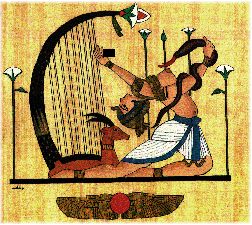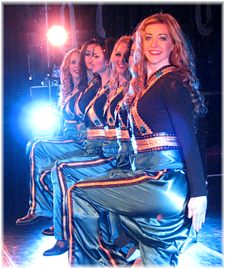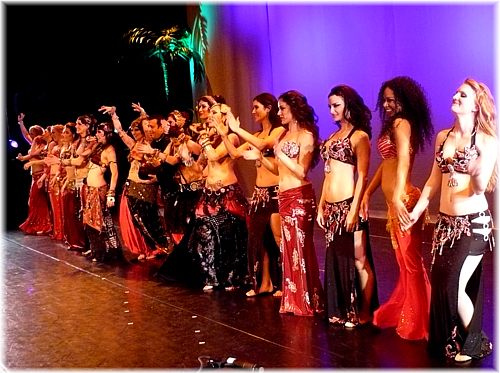Belly Dance from Cairo to Los Angeles

Personal Commentary on the Bellydance Superstars
by Roza Shahrazad
posted September 9, 2009
Egyptian and American Belly Dance: how different can they be? I lean back into my plush red velvet chair and begin to count the ways. Armed with my research, experience, numerous trips to Egypt to study dance and an Egyptian in the seat next to me, I prepare to enjoy and evaluate the American phenomenon known as The Belly Dance Superstars, in comparison to superstars on the international level, hailing from Egypt, such as Dina,Randa, and Tito.
The lights dim and the curtains open, catapulting us into what is clearly a backdrop modeled on a pharonic amphitheater—cool! Luxuriously layered shades of rich bold colors are projected like a film on the stage backdrop. They oscillate and metamorphose into a number of intriguing designs, curiously, in harmony with the apparent pharonic theme.
I remember the saying "Cairo is the Hollywood of Bellydance" is for a reason, and I think the ancient Egyptian theme takes us back to where the roots are deepest.
Even The Cairo Museum contains a multitude of representations of this ancient dance, from funerary to temple, dancers on the Nile boats, and rites of passage, and other rituals are testament to how deeply this dance is entrenched in the Egyptian Culture. It existed there prominently for thousands of years before the advent of Islam, and the current paradox that exists today is a result of this coming together of two distinct cultures and the importance of religion in the region.
The BellyDance Superstars added many elements unknown in Bellydance to their performance: back handsprings and flips by gymnasts, American Tribal dancers, and ballerinas, which introduced aspects of Indian, African, and European dance. It added an element of impressive and exciting entertainment to attract an audience in the West. However, it did not impress the Egyptian in the seat next to me; in fact, it insulted his sensibilities!
By the time Middle Eastern dance reaches North America, a very small amount of it remains, like the game telephone, meaning is lost in passage, which means a limited creativity within a limited genre.
While in Cairo, I was advised that all Bellydance evolved—most recently—from Folk dancing. Each Folk dance class was extremely illuminating of the style, steps, interpretation of songs and their region, and in the case of Sufism and other types of dance, even spirituality, energy control, and distribution. It is interesting when the Egyptian dance teachers, like Dr. Mo Gedawwi, show us exactly how the move looks in Folk dancing and how it looks when used in the Oriental style (what, unfortunately, Americans call the “Cabaretstyle”).
In some countries, (notably, Brazil, Argentina, or Russia), the dancers do learn a great deal more folkdance and musical theory, and therefore, have a richer repertoire of moves and a deeper understanding of the dance. In my opinion, in North America (the United States in particular), a great interest in, or respect for, the ways of native cultures has never been a priority. However, Capitalism demands that money is a priority. Ironically, in order for art to continue to exist, money matters.
 Money enabled the costuming and grooming to be exquisite for both the top Egyptian and American dancers. Spectators dressed well to attend this show. In Egypt too, Arabic people come from all over the region to see performers and can do so in an elegant five star restaurant, a cruise ship, or a “cabaret,” which is inelegant. Egypt is the media center, known for its movies and political center throughout the Middle East. Dancers are part of that media milieu. A top Egyptian Dancer can command $15,000 dollars (plus airfare and hotel), for herself and her orchestra, which could be twenty or more people. In Phoenix, Arizona, a dancer with a CD makes $25-$100 dollars plus tips to dance in a restaurant. Dancing at parties or weddings will bring significantly more, but clearly, the way in which Egyptian performers are treated, good, bad, and ugly, is deeply rooted in their culture and not truly comparable to other regions.
Money enabled the costuming and grooming to be exquisite for both the top Egyptian and American dancers. Spectators dressed well to attend this show. In Egypt too, Arabic people come from all over the region to see performers and can do so in an elegant five star restaurant, a cruise ship, or a “cabaret,” which is inelegant. Egypt is the media center, known for its movies and political center throughout the Middle East. Dancers are part of that media milieu. A top Egyptian Dancer can command $15,000 dollars (plus airfare and hotel), for herself and her orchestra, which could be twenty or more people. In Phoenix, Arizona, a dancer with a CD makes $25-$100 dollars plus tips to dance in a restaurant. Dancing at parties or weddings will bring significantly more, but clearly, the way in which Egyptian performers are treated, good, bad, and ugly, is deeply rooted in their culture and not truly comparable to other regions.
Treating Bellydance with respect, in a classical theater with a polite, audience in attendance was welcome to me. However, I do enjoy seeing Bellydance in an Arabic restaurant setting because of the intense debates that can follow a performance as well as the interaction and emotion displayed by members of the audience as well as the dancers.
The narration at the beginning of the show confronted the hard questions in a correct and straightforward manner and asserted that the time had arrived in which Bellydance has earned the respect it deserves.
 The choreography was very professional and sumptuously presented with a full cast, emphasizing a sense of sisterhood between the cabaret and tribal dancers. I was pleasantly surprised that all dances in the show were correct for the genre of music, i.e., Shaabi was danced in the Shaabia style, clearly, and Classical music with Classical dance, Hip-hop with American Tribal, and Bellydance, dabka with Lebanese music, etc. Too often, in America, I see beautiful Egyptian moves performed with a Turkish song or Pop/classical danced to Shaabi. I noted that the American Bellydance style was performed to any range and scope of music, thereby negating the music/dance connection. So, I concluded that The Belly Dance Superstars were aware, professional, and great fun.
The choreography was very professional and sumptuously presented with a full cast, emphasizing a sense of sisterhood between the cabaret and tribal dancers. I was pleasantly surprised that all dances in the show were correct for the genre of music, i.e., Shaabi was danced in the Shaabia style, clearly, and Classical music with Classical dance, Hip-hop with American Tribal, and Bellydance, dabka with Lebanese music, etc. Too often, in America, I see beautiful Egyptian moves performed with a Turkish song or Pop/classical danced to Shaabi. I noted that the American Bellydance style was performed to any range and scope of music, thereby negating the music/dance connection. So, I concluded that The Belly Dance Superstars were aware, professional, and great fun.
Since Arabic Music is built on a natural scale, while European music is on a tempered scale, and media has allowed the West to assert its preference world wide, it is difficult to present natural Arabic music to a western audience, as they tend to find Arabic music unattractive and dissonant. The Belly Dance Superstars produce the music in a hyped-up, westernized version in order to appeal to a larger audience.
While Arabic music is hard for westerners to understand, it is equally (or more) true that “American Tribal dancing” doesn’t translate as “Bellydancing” to Middle Easterners. It is the antithesis of what Bellydance represents in Middle Eastern culture. Since the dance represents a woman’s beauty, joy, and social cohesion, in its native environs, and tattoos and piercing are considered both unattractive and “haram” (forbidden or sinful), it is easy to recognize the culture shock that ensues, based on appearance alone.
To be honest, the Egyptian in the seat next to me hissed, “I hope you don’t think this is Bellydance!” more than once. Finally, he confronted his difficulties by closing his eyes and feigning sleep while the American Tribal dancers performed.
Bellydance, especially in Egypt, could be called a cultural objective and could also be compared to a football game in the U.S., in that the game is only part of the picture. Society has created a string of events corresponding to football games such as: selling t-shirts, placing bets, and as well as having barbecues and get-togethers, there are team rivalries and debates.
In Egypt, this dance was born to tie communities together. The dancer communicates and interacts with her audience. It is the only dance that was conceived as an interactive dance, in which she expresses the words and emotions of the music or song with her hand gestures, facial expressions, and movements.
It was not meant to be simply a performance to watch. The movements all have meanings, which express the music and words of the song. It recreates personal and patriotic dramas through which people have lived—together—as a society. This aspect cannot be over-emphasized!
 In sociology, sociologists refer to Egypt as a “collective society." On the other hand, the U.S. is an “individualistic society.” Going back to the cultural objective, and keeping in mind that Egypt is a collective society, it makes sense that Egyptians and most Middle Easterners might want to participate in a dancer’s performance. They may want to get up and dance too; they will want to critique and debate. In Egypt especially, most dancers (and their good and bad qualities) are known and debated passionately. In Egyptian markets and stores Bellydance costumes are often in evidence, like t-shirts in the U.S. They have a large industry, luring the foreigner to come and learn their authentic version of this ancient art that has been passed down from pharonic and deity worshipping rituals, to Folk dance, to the performance art that it has become today.
In sociology, sociologists refer to Egypt as a “collective society." On the other hand, the U.S. is an “individualistic society.” Going back to the cultural objective, and keeping in mind that Egypt is a collective society, it makes sense that Egyptians and most Middle Easterners might want to participate in a dancer’s performance. They may want to get up and dance too; they will want to critique and debate. In Egypt especially, most dancers (and their good and bad qualities) are known and debated passionately. In Egyptian markets and stores Bellydance costumes are often in evidence, like t-shirts in the U.S. They have a large industry, luring the foreigner to come and learn their authentic version of this ancient art that has been passed down from pharonic and deity worshipping rituals, to Folk dance, to the performance art that it has become today.
With this in view, it is easy to see that when Tribal dancing starts with its slow, sustained poses, showcasing the dancers moves vs. movements that communicate meaning and express the music, it creates a serious sense of “disconnect” for an Arabic audience. In addition, there is little connection to the rhythms, which would, ordinarily, dictate whether the dancer should be traveling or stationary, etc.
Despite the loss of many original elements, some very important and impressive elements remain: the spinning taken from proper Sufism style was present throughout, as were tastefully added nods to moves and choreography created by Egyptian masters such as the Mahmoud Reda Troupe or Dina. They were never copied, but added sparingly, as a spice, impressing me with the level of knowledge obtained by the choreographer especially.
Sonia‘s drum solo was stunning! My hat is off to her. Although she was accomplished before, she is even better now! Issam was brilliant and charming, as always, and truly uplifting; in fact, he was positive and gracious. Zoë managed to infuse an incredible persona into her drum solo. Ending the show with the traditional ending song, “Layla, Layla, Layla,” was another brilliant and ingenious statement by the choreographer.
While it was true that some of the more experienced dancers weren’t present, and it was clear some of the dancers had more practice than others, I thought the show was a grand success all in all. To some degree, I felt it achieved what Um Kalthum did when she collaborated with the innovative Mohamed Ab El Wahab: her classicism and his freshness paid off in terms of some of her greatest work such as "Inta Omri." In like fashion, I have hope that more shows like this one will pay off for all of us who wish Bellydance to become the respected art I believe it can be.
Have a comment? Use or comment section at the bottom of this page or Send us a letter!
Check the "Letters to the Editor" for other possible viewpoints!
Ready for more?
- 4-28-09 Photos from the 2008 Tour of the Bellydance Superstars
Marin Civic Center, San Rafael, March 1 2008 - 3-27-06 The Bellydance Superstars Show In Perspective
There are many factors to balance, and ANY show can be improved. The point is to also know the limitations that one faces in doing all the things one would like to do. - 7-27-04 Belly Dance Superstars at DNA Lounge
More eye candy! Performing in one of the most trendy clubs in San Francisco! - 12-9-03 Miles Copeland Responds to Questions from GS Readers
If we are to dominate the world let’s try to understand and appreciate the good in other cultures as we are trying to mitigate the bad. - 9-8-09 Ask Yasmina #9: Teaching Differences, New Troupes, Men in Bellydance
As an ensemble becomes larger and more professional, it will find that it is more efficient and effective if it models itself like a professional company
with defined roles - 9-1-09 Maud Allen: La Femme Fatale
For, as the trial progressed, in effect, it became a trial of female sexuality. No respectable woman, it was claimed, could possibly take on the sadistic role of Salome unless she was a sadist in real life, and sadism was regarded at the time as a practice verging on the criminal. - 8-28-09 Carl’s Photos from The 2009 Gala Showcase at the SF/BA MECDA Event
Event Presented by SF/BA MECDA (the San Francisco Bay Area Chapter of the Middle Eastern Culture and Dance Association) Held on January 17 at the Cubberley Community Quditorium in Palo Alto, California

Sorry, comments for this entry are closed at this time.